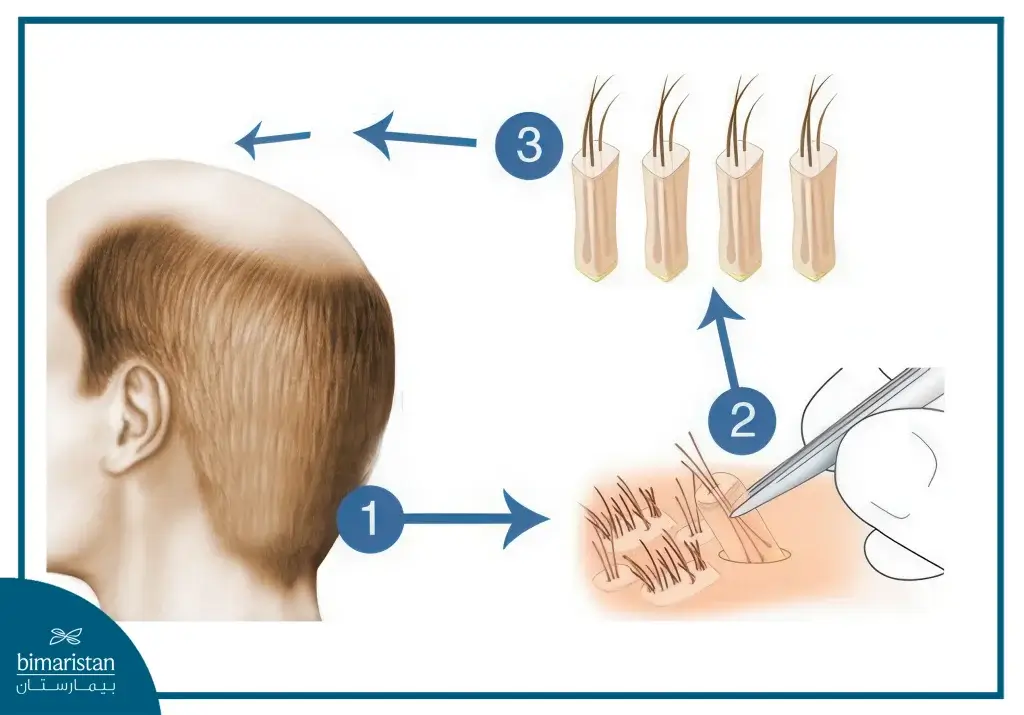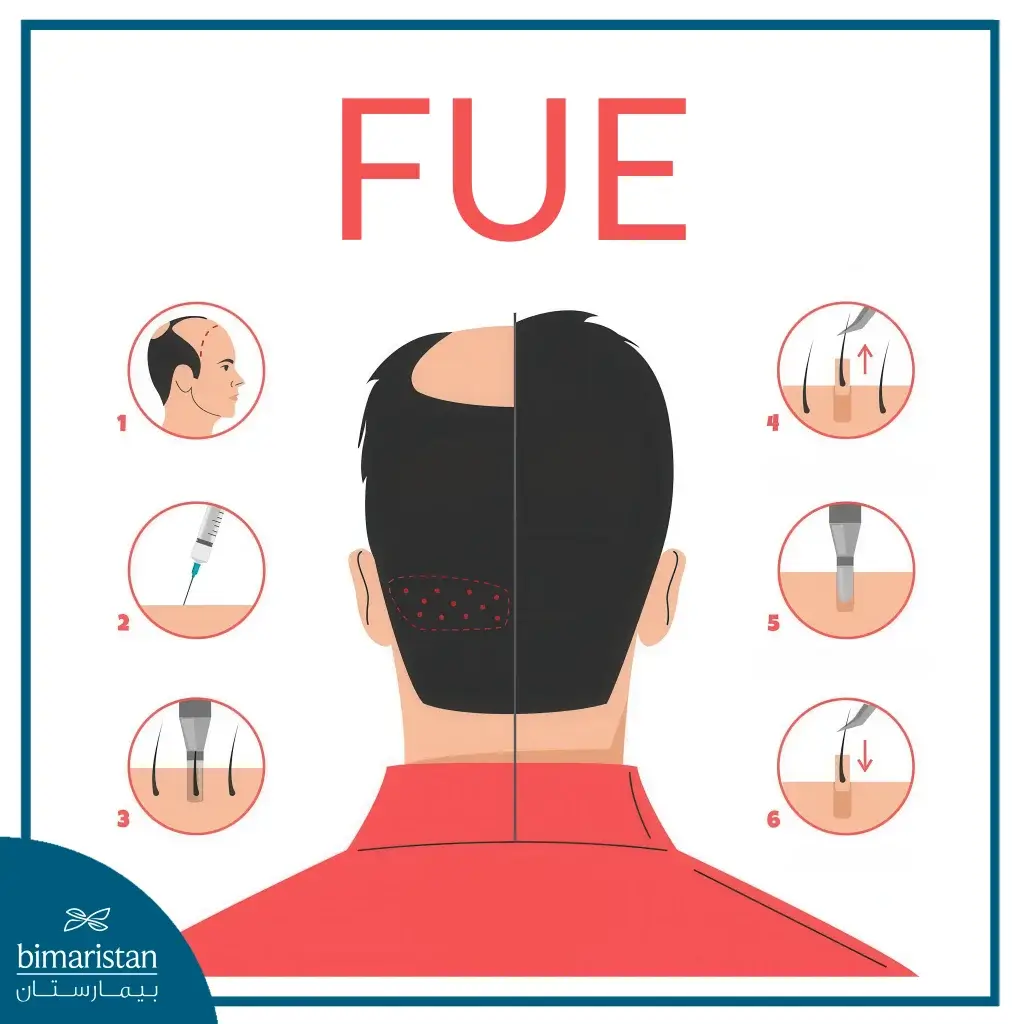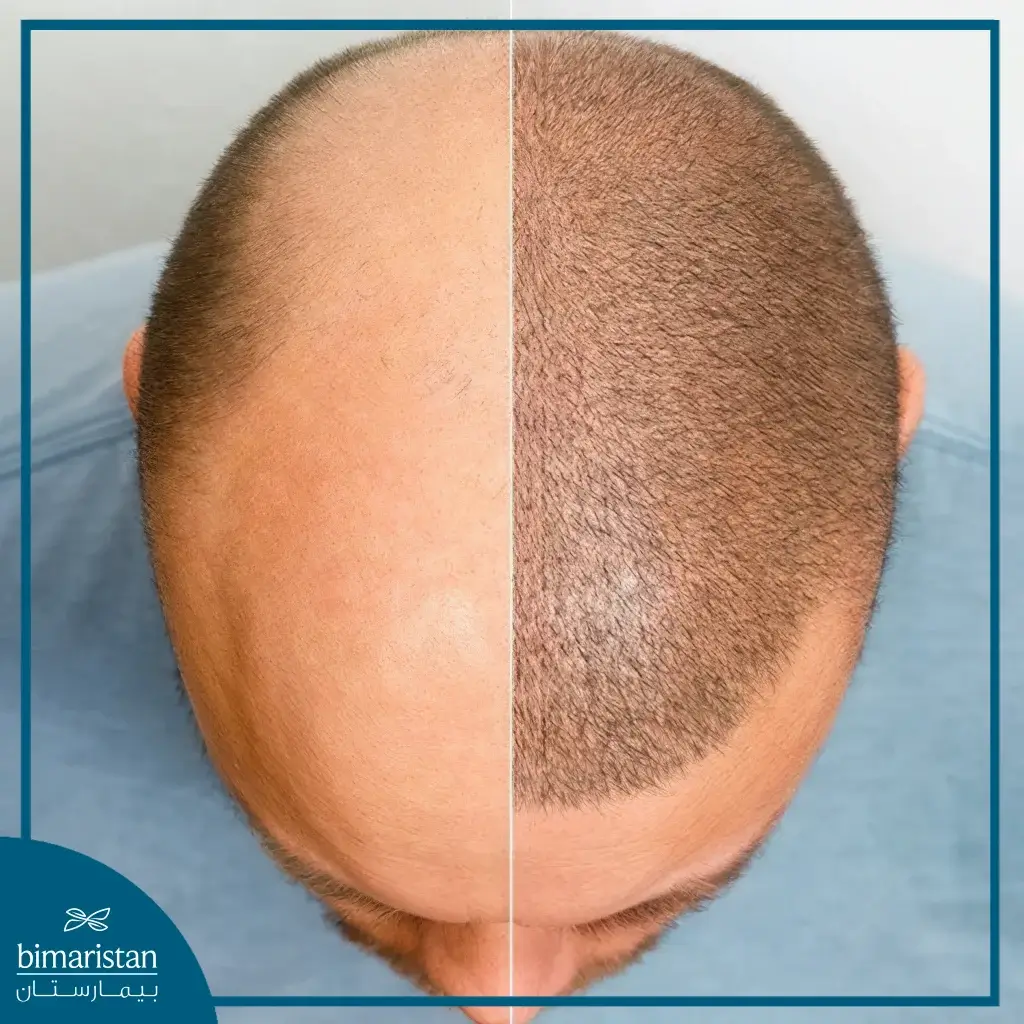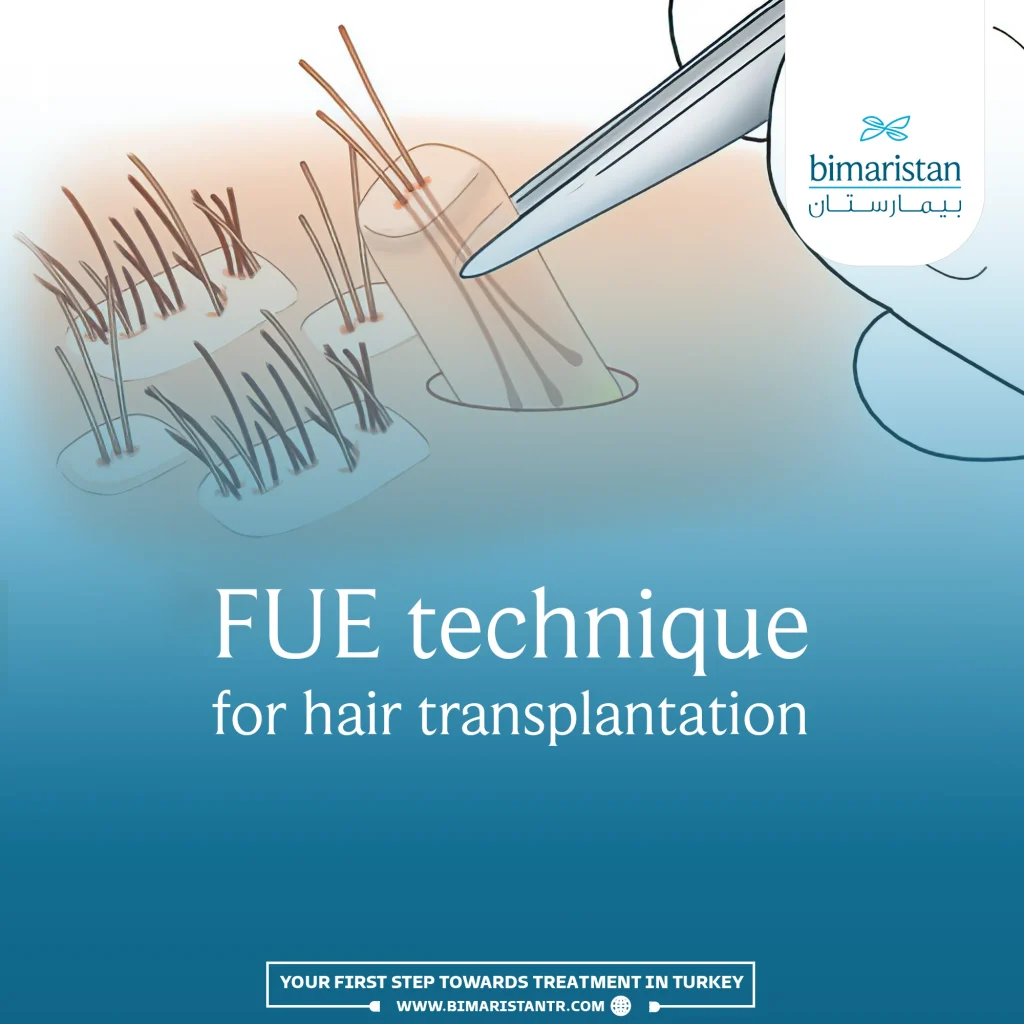The FUE hair transplant or extraction technique is the most commonly used technique for treating hair loss as a non-surgical procedure.
There are many different techniques for hair transplants. Still, Follicular Unit Extraction (FUE) is the preferred technique for treating common hair loss problems worldwide, such as male pattern baldness and alopecia areata. This is because it does not leave visible scars on the scalp, causes less pain than other techniques, and reduces the size of the medical team involved in the procedure, thereby lowering the costs of the procedure.
This technique relies on extracting hair follicles and placing them in a particular solution before transplanting them into the area with thinning hair. Currently, efforts are being made to develop other techniques from this method, such as directly transplanting follicles after extracting them from the donor area. Therefore, the FUE hair transplant technique is considered the cornerstone in Turkey’s hair transplantation field.
What is the FUE hair transplant technique?
The FUE hair transplant technique is a relatively modern procedure that involves extracting individual hair follicles, usually from the back of the head, one at a time under local anesthesia and then placing them in a particular solution for re-implantation into the area with thinning hair using fine instruments to avoid any scars.

Currently, efforts are being made to develop other techniques from this method, such as directly transplanting follicles after extracting them from the donor area. Therefore, the FUE hair replacement technique is the cornerstone of Turkey’s hair transplantation.
The solution in which the follicles are kept must have the following properties:
- Nourishes the existing cells
- Not toxic to the cells
- Inhibits bacterial growth
- Prevents cell clumping or damage
- Maintains the vitality of the cells for as long as possible
- Facilitates the return of cell function when warmed
The Follicular Unit Extraction (FUE) technique has been developed from the Follicular Unit Transplantation (FUT) technique, which involves making a long incision in the scalp, taking a strip of skin, and placing it in the bald area. However, this technique leaves a noticeable scar, prompting doctors to innovate the FUE technique to conceal the surgical scar.
Doctors have developed a method derived from the fue hair transplantation technique, known as sapphire fue technique, in which sapphire blades are used in the implantation pens instead of metal ones.
Indications for the FUE hair transplant procedure
The FUE hair transplant technique in Turkey is performed in the following cases:
- For individuals experiencing mild and limited hair loss that requires simple sessions to restore it, including patients with third-stage Androgenetic Alopecia in the Norwood classification, or patients with small areas of baldness.
- Small areas include the widow’s peak (a small triangular area where hair falls out at the top of a woman’s head), eyebrows, mustache, chin, and patches resulting from skin diseases.
- Scarring due to congenital, surgical, or FUT reasons.
- Individuals with thinning hair in the donor areas or those with severe scalp adherence to the bone.
- For those who want to shorten their hair after transplantation, the FUE technique does not cause scarring after the procedure.
FOX test for FUE hair transplant
The FOX test is performed on the first extracted follicles in the procedure. It determines the ease of extracting the follicles and the possibility of transferring them, making it the standard for the success of the FUE hair transplant technique.
The FOX test has five scores, with the first and second scores being the best for performing FUE. The third score depends on the surgeon’s experience in estimating its feasibility, while the fourth and fifth scores are preferable for considering other methods for hair transplantation.
| Score | Criteria | Significance |
| 1 | All follicles were extracted intact with no difficulty | Excellent, positive FOX |
| 2 | Good loss of surrounding fat in the lower part of the follicle | Good, but there may be difficulties in the upcoming sessions |
| 3 | Different harvesting angle | Doubtful, and in need of expert doctors |
| 4 | Significant loss of surrounding fat and a large number of follicles detached from their distant section | Weak, negative FOX |
| 5 | Significant damage to most of the extracted follicles. | Weak, negative FOX |
Preparing for FUE hair transplant
Some blood and non-blood tests are performed before the surgical procedure, and the patient is asked to shave or trim their hair as much as possible.
Donor area density test before FUE hair transplant
This test determines the possibility of taking hair from this area and whether hair removal will affect the appearance of the hair in this area. It also determines the density of the hair in the donor area before the procedure to avoid an unattractive appearance after hair removal from the donor area.
Routine tests before FUE hair transplant
Routine blood tests such as complete blood count, coagulation tests, bleeding time, and blood sugar are requested before FUE hair surgery.
An allergy test is also performed to ensure the patient is not allergic to the medications given during the FUE hair implant.
The Bimaristan medical team will support you from the moment you decide to undergo hair transplantation in turkey, assisting you with travel procedures and flight bookings, through your arrival and stay near the hair transplant clinic you choose. they will also guide you through the advantages and risks of the various hair transplant techniques and will continue to follow up with you after the procedure to ensure you achieve satisfactory results as soon as possible. all you need to do is contact us.
FUE hair transplant technique
First, the hair is shaved and the surgical area is prepared, ensuring all necessary FUE transplant tools are available.
Stages of FUE hair transplant in Turkey:
- Follicle hair transplant begins with the donor area (usually the back of the head) being locally anesthetized. The border of the donor area is marked, and a small number of hair follicles are then extracted using a pen-like device that surrounds the follicle. The follicle is cut toward the original hair and removed with specialized forceps.
- After hair follicle extraction, it is tested and its score is determined on the FOX scale. If suitable, the rest of the hair follicles are collected individually and stored in a saline or Ringer’s lactate solution for transplantation the next day. Currently, the patient’s plasma is used to preserve the hair follicles, showing promising results regarding reduced hair loss and less use of other medications in the post-surgical stage.
- On the second day, the recipient area is anesthetized. The follicles are transplanted using a specialized tool that creates small incisions according to the number of follicles extracted to place each in its designated place. The head is then covered and the patient is given some medications such as antibiotics, painkillers, and steroids.
- The hair then begins to grow for four months, during which the patient notices changes in the appearance of the transplanted area and the disappearance of FUE scars as the hair grows directly.
- After this stage, the hair density stage begins, during which the hair takes its final shape similar to natural hair, and thus, the desired final result of FUE hair transplantation in Turkey is achieved.

Post-FUE hair transplant follow-up
Instructions from the doctor after FUE hair transplant:
- Be sure to visit the clinic on the third day after the hair transplant to ensure the procedure’s success and remove the cover from your head. The doctor may confirm the use of recommended shampoos or hair nutrients.
- Between the first and sixth month, the doctor ensures healing, hair growth, and the condition of the hair follicles. During this period, minoxidil and hair growth stimulants can also be considered.
- The doctor may use platelet-rich plasma injections after two months of surgery, which have shown promising results compared to not using them.
- After the sixth month, a medical clinic review is conducted to ensure healing and hair growth, possibly using other medications or resorting to another surgical treatment.

The following is a picture of a patient who has suffered from hair loss from a FUE hair transplant before and after the surgery.
Tips after FUE hair transplant
Here are some tips and instructions after FUE hair transplantation in Turkey:
- It is preferable to sleep with the head slightly elevated.
- Avoid tilting the head, strenuous activities, swimming, and applying alcohol.
- Irrigate the transplanted area with saline solution and apply ice to the forehead and around the eyes.
- Avoid prolonged sun exposure during the day.
Complications of FUE hair transplant
As with any other surgical procedure, complications may occur during the surgery related to the surgeon performing the procedure and the location of the procedure, such as bleeding and anesthesia-related issues. At Bimaristan Medical Center, we strive to keep these complications to a minimum by guiding you to the best-specialized doctors to perform the procedure, and we ensure that all of our operations are carried out in the best Turkish hospitals to achieve the best results.
After the follicular unit extraction procedure, you may experience the following:
- Pain
- Swelling
- Edema in the forehead or around the eyes
- Itching
You can quickly treat these symptoms by taking the medications prescribed by the doctor. Late complications of FUE after one month are rare but may require a visit to the doctor to ensure the success of the procedure, and may include:
- Hair restoration may be delayed
- Inflammation of the hair follicles
- Scarring on the scalp
- Persistent pain
Advantages and disadvantages of FUE hair transplantation
The advantages of FUE hair transplant in Turkey are:
- Hair transplant without scar (Leaves less scarring than FUT)
- Shorter recovery period after surgery
- Body hair can also be used for transplantation
- Less risk of nerve damage during hair follicle extraction
As for the disadvantages of hair transplantation by extraction:
- It takes longer compared to other methods
- There is a greater possibility of burying the hair follicle under the skin and causing inflammation
- Requires a larger donor area
- It may require multiple sessions for larger areas, as extracting 1000 hair follicles can take about 3 hours of surgical work.
FUE hair transplant cost in Turkey
FUE transplant cost starts from 1200$ US Dollars in Turkey and varies depending on the area that needs hair transplantation and the method of extraction and solution used to preserve the hair. Contact us so doctors in our medical center can evaluate your case, decide on the procedure details, and inform you of the cost of follicular unit extraction FUE for your hair transplant.
Some advancements in the FUE technique for hair transplantation
Some procedures are currently being done without preserving the extracted hair follicles in a particular solution, where the hair follicles are extracted and implanted directly into the recipient area, saving time and reducing complications of hair transplantation with the solution. This technique is called Direct Hair Implantation (DHI).
A method to heal hair follicles using stem cells is being considerd, but it is still under development.
In conclusion, FUE hair transplant is the best technique and is currently the most widely used technique in the field of hair transplantation in Turkey due to its lack of visible scars on the one hand and its high success rate on the other. The procedure is done under local anesthesia and in a simple manner, as mentioned earlier. The hospital center provides the best expert doctors in this method to ensure the best results closest to the natural appearance.
Some of the references used to write the article:
- Follicular Unit Extraction (FUE) Hair Transplant: Curves Ahead.
- FUE hair transplant: how I do it?
- Follicular unit extraction hair transplant harvest: a review of current recommendations and future considerations.
- Hair Transplant Surgery for Hair Disorders, Dr.Bessam Farjo.
